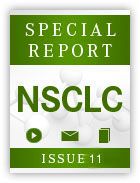Addressing the Challenges of Treating Non-Driver NSCLC
Targeted therapies have revolutionized the treatment of patients with non–small cell lung cancer; however, not all patients harbor identifiable driver mutations. Standard treatment options among patients lacking molecular targets include chemotherapy and antiangiogenesis agents.
Specifically, in those patients whose tumors are not driven by mutations such asALKorEGFR, the angiogenesis inhibitors ramucirumab (Cyramza) and bevacizumab (Avastin) have emerged as effective treatment options.
The VEGF inhibitor bevacizumab has been approved since 2006 for use in combination with carboplatin and paclitaxel as a frontline treatment for patients with unresectable, locally advanced, recurrent/metastatic, nonsquamous NSCLC.
In 2014, the FDA approved the VEGFR-2 inhibitor ramucirumab in combination with docetaxel for patients with metastatic NSCLC whose disease progresses during or following platinum-based chemotherapy. The indication includes patients with both squamous and nonsquamous disease, as well as those whose tumors areEGFR- orALK-positive who have progressed on targeted therapy.
In an interview withTargeted Oncology, Ralph Zinner, MD, director of the Head and Neck Cancer Program and Lung Cancer Program at Thomas Jefferson University, discussed available and emerging approaches for treating patients with non-driver NSCLC.
Targeted Oncology: What challenges currently exist with identifying biomarkers in NSCLC?
Zinner: The 2 classes of NSCLC that we are addressing are those that are squamous and nonsquamous. They are often addressed separately because they are so different.
With nonsquamous, there’s been an abundance of markers. When you know about them, you can either make a medicine that can target those markerswhich helps those people—or it can help you to produce a medicine that might work better because you know [they have an abnormality].
However, it is possible that the large majority of patients still lack a marker that is especially meaningful. The challenge is to see if there are additional markers that can be targeted. In squamous, this is even more the case. There are fewer markers that have been identified for which drugs have been developed.
Antiangiogenesis agents and chemotherapy are standard treatments for patients lacking driver mutations. Are there studies exploring other options?
There is the CheckMate-227 study, which is a randomization across a number of arms for the treatment of first-line metastatic NSCLC. It is asking very important questions about whether immunotherapeutics,
the checkpoint inhibitors alone or in combination, can offer benefit over the standard. They are important, not only because we want improvements, but also because the implications are a little bit different than they used to be.
In the past, our orientation was toward improving the median survival time and, increasingly, we are noticing that there are a percentage of patients who are having a very durable response. That is something different from what we have experienced, and so if we can institute these kinds of drugs earlier, we are going to be helping people in a way we couldn’t before. That is an example of one study.
What do you hope that community oncologists will take away from your presentation at the meeting?
My presentation was not so much on the immunotherapeutics, so I think that there are these medicines that are available to help people, especially if you’re asking about markers.
For example, since an EGFR inhibitor is a monoclonal antibody, people who have EGFR abnormalities that are not mutated would not be benefitting very much from certain drugs that target mutatedEGFR. The drugs that I discussed actually can help those specific patients, and so it expands the range of opportunities.
Likewise, with antiangiogeneis inhibitors, there are actually opportunities out there that I think people know about. Finally, these medicines exist and can be beneficial to people today in the fashion that it means that these drugs are meaningful. Why is that important? We are increasingly combining medicines. Therefore, there is another opportunity. Every medicine that shows it could do something is fairly convincing as an opportunity to combine with something else and improve care further.
Is there anything else that you would like to highlight?
The first setting in which we use new medicines, and I discussed medicines that are somewhat new, is in advanced disease after patients have previously been treated.

Survivorship Care Promotes Evidence-Based Approaches for Quality of Life and Beyond
March 21st 2025Frank J. Penedo, PhD, explains the challenges of survivorship care for patients with cancer and how he implements programs to support patients’ emotional, physical, and practical needs.
Read More